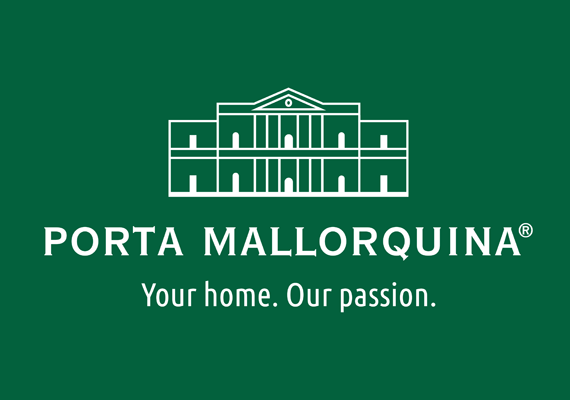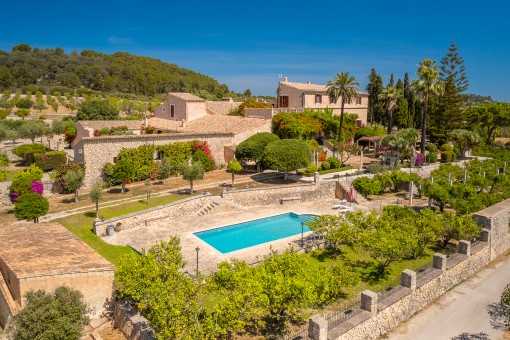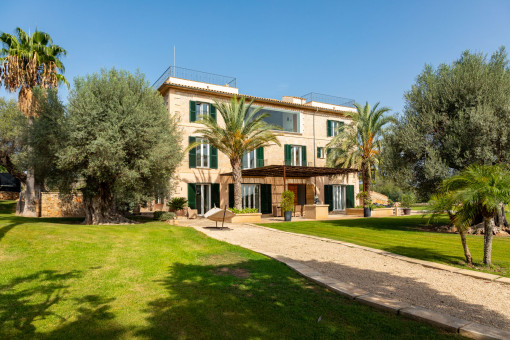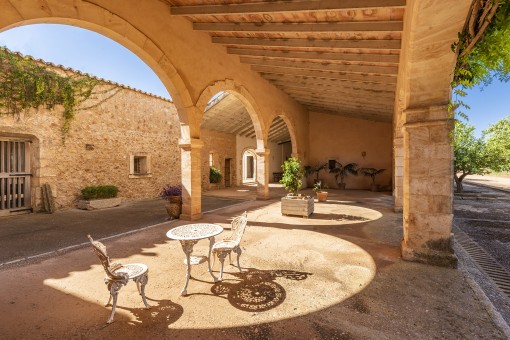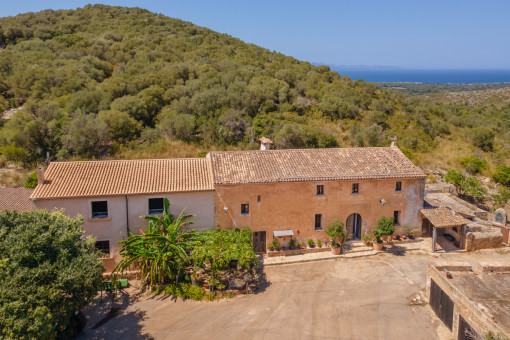Mallorca offers an incredible diversity whether scenically, culturally or culinary, but also in the area of real estate. With the latter more and more buyers are discovering a love for historic properties. For lovers of older buildings there are attractive property options ranging from historic fincas and town-houses to old monasteries and mills, all reflecting the unique characteristics and charm of the island. These centuries-old treasures can be found particularly in the central part of the island, although they also exist in other regions of Mallorca. Handled with passion and patience historic properties become unique objects with great potential to increase in value. Where, however, can they be found and what needs to be considered when buying and renovating?
Contents
- Historic properties across the island
- Our selection of historic properties
- What distinguishes historic properties on Mallorca
- What to consider when purchasing an historic property in Mallorca
- What to take into consideration when renovating an historic property in Mallorca
- Revitalising historic properties on Mallorca is a win-win situation
Historic properties across the island
Historic properties can be found all over Mallorca. They are witnesses of the island’s exciting, centuries-old history and offer a real and authentic Mallorca-feeling.
A large selection of non-renovated properties can be found in the central part of the island. The idyllic central area is no longer an insider tip, but nonetheless property owners and holidaymakers are always pleasantly surprised by its advantages, away from the coastal hotspots and with beautiful landscapes, historic villages, castles and monasteries. Prices here are still moderate – as the latest study of the holiday property market in Mallorca has once again confirmed.
Palma, the capital of Mallorca, also looks back on a fascinating past with its historic districts and city palaces.
Alcúdia, a medieval town on the north-east coast, is surrounded by a well-preserved 14th century city wall with narrow cobbled streets leading to picturesque squares, historic churches and traditional houses.
Nestled in the Tramuntana mountains is Pollença, a charming town with a very rich history.
The picturesque town of Soller in the north-west is well-known for its charming architecture and impressive landscape, and contains beautiful modernist buildings including the town hall and the railway station.
Valldemossa is a charming village in the Tramuntana mountains and is famous for its Carthusian monastery. The narrow streets are adorned with blooming flowers, while historic stone houses exude a unique charm.
Our selection of historic properties
More historic properties:
Historic town-mansion with potential for various uses in Mancor de la Vall
Grand and historical 17th century Mallorcan Finca in Esporles with imposing panoramic views
Quietly-situated manor house in need of renovation in Algaida
Beautiful mill with 2 terraces in Sant Llorenc des Cardassar
What distinguishes historic properties on Mallorca
As a rule historic properties in Mallorca are generally at least 100 years old, and some of the oldest fincas even date back to the 14th century. They were first used as country estates and for farming, and many were converted into spacious country houses during the 18th century when they served as holiday domiciles for aristocratic and wealthy families. During the 20th century, however, many such properties were abandoned and fell into disrepair, but during recent years many of these old treasures have been rediscovered. Such properties can often offer a proven historical heritage and present a unique opportunity to partake in the history and culture of Mallorca.
There is much to be said for buying such a property including:
- Charm and style: Historic fincas in Mallorca are known for their charm and their style, which is often accentuated by traditional features such as natural-stone walls, wooden ceiling beams and terracotta tiles bestowing a unique atmosphere and a special charm upon the properties.
- Exclusive lifestyle: Such objects provide an exclusive lifestyle surrounded by idyllic countryside and breathtaking views, and stand on plots of land which are generally very large and offer the corresponding amount of privacy. Important point – the constructed area is also often very large and could not be approved for new construction today.
- Holiday rentals: Historic fincas on Mallorca offer great potential for holiday rentals, as more and more people are appreciating the advantages the centre of the island offers. Because of this such properties are often converted into hotels or B&B’s, of course after first obtaining the appropriate touristic rental licences.
- Investment properties: The renovation of a historic property can, of course, also be attractive from an investment perspective. In addition to the returns from renting, there is also the increase in the value of such unique properties over a period of time.
What to consider when purchasing an historic property in Mallorca
Those who do not already live on the island will certainly require the assistance of a local advisor when seeking their dream historic property. There are, of course, a wide variety of legal regulations which must be observed when planning to renovate an historic building in Mallorca.
“For that reason you should seek professional advice initially when starting your search for a property. This saves time, money and nerves,”
says architect Bernd Schmahl.
The Hamburg architect has been living and working in Mallorca for over 25 years.
“It is of considerable importance to know excactly what you are buying. Not only whether the buildings are listed for protection, but also which protection levels exist for a specific object, and the state of its basic structure.”
Protection level A in Mallorca, for example, stipulates that the room layout may not be changed. Property protection levels (forest, agricultural, river) can also restrict future building measures and possible uses. If you are not made aware of this you may be in for a nasty surprise after the purchase. In addition, advises Bernd Schmal, a good 95 % of such properties in the countryside of Mallorca have had unauthorised building measures and additions – an extension, for example.
Extensions etc. added before 1956 are, however, automatically legal but should this not be the case it must be examined whether such additions are able to be legalised. For this reason added constructions on 200 to 300 year old properties are not necessarily a criterion for potential buyers to abandon their plans to purchase. . Prospective buyers must, nevertheless, get advice and be aware of these details in order to take them into account in the case of future planned renovations or refurbishments.
An architect can assist prospective buyers with the following:
- Construction-technical support before and during purchase
- Examination of the construction substance
- Examination of legal construction issues and protection levels
- Planning of renovation and/or refurbishment
- Coordination and processing of permits by local municipal authorities
- Supervision of construction work on site
What to take into consideration when renovating an historic property in Mallorca
After purchasing Bernd Schmahl recommends that his clients get to know their property for a while and reflect on their impressions.
“Once you have spent a few weeks in the property you may understand why the previous owners did not remove that wall, or why there is not a large window in that room”.
As far as the duration of approval procedures is concerned, there is no rule in practice. The speed of the procedures varies greatly from municipality to municipality and, of course, also depends on the extent of the planned conversions. In principle, however, the speed of movement of Mallorcan bureaucracy should be taken into account and a few months delay should be included when planning.
During the conversion itself, the following should then be considered:
- Preservation of historical details in combination with modern elements: When renovating historical buildings the aim should always be to preserve and restore original details such as wooden beams, natural stone walls, brick arches and also old wooden elements such as doors and windows, according to the stipulations of the local authorities. In this way the original character of the building will be preserved although, if the project and the authorities allow, modern elements could also be incorporated.
- Meeting modern standards: While historic buildings often have their own charm, they must also meet modern standards as far as is possible. For this reason aspects such as electricity, plumbing and heating systems, and insulation and ventilation should be taken into account during the renovation.
- Use of high-quality materials: When restoring historic buildings, high-quality and/or even traditional materials should be used which are similar to the existing, original material to ensure an harmonious appearance.
- Work with experienced craftsmen: To ensure that the refurbishment is carried out to a high-quality and professional standard craftsmen with experience in the restoration of historic buildings should be used
Revitalising historic properties on Mallorca is a win-win situation
Those seeking a very special property are sure to be successful with an historic building in Mallorca. These buildings often have unique features no longer found in modern architecture, and through renovation they can be brought back to life and play an important role in the cultural heritage of the community.
Owners often fulfil a lifelong dream with an historic property, and in addition their potential for value appreciation is high as they are often still located in favourably-priced regions and have unique characteristics. The restoration of an historic property, however, requires a great deal of preparation, commitment and financial resources to preserve its unique features whilst simultaneously meeting current standards of living comfort and safety as far as possible.
For the local municipality the rehabilitation of historic buildings also brings numerous benefits, as the restoration of these buildings assists in the preservation and promotion of the cultural heritage of both the community and Mallorca itself. They can serve as a local point of reference and enhance the impression of the town. For this reason the positive effects on tourism and the economy of the municipality should not be underestimated.
It is certainly true that a well-restored historic property in Mallorca is unique, imparting upon the new owner a distinctive prestige, as well as becoming a new Mediterranean home. In this way the revitalisation of historic properties becomes a win-win situation for the new owners and the local community, and adds to Mallorca’s cultural assets.
